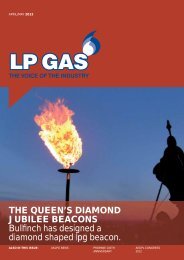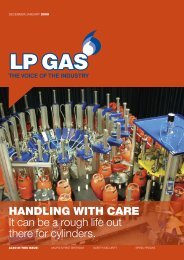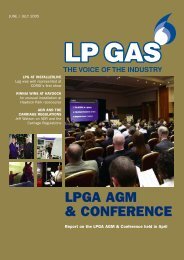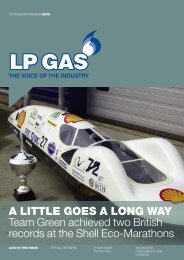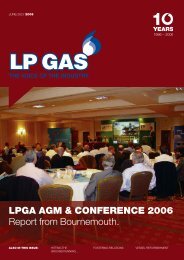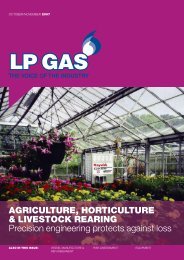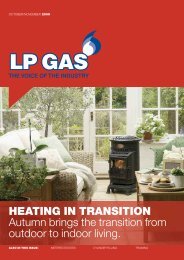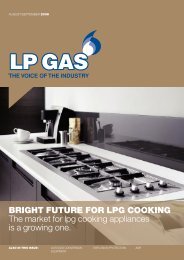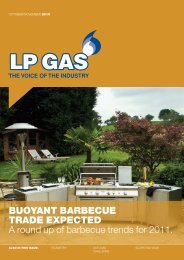C2572 02 Apr-May 06 AW - LP Gas Magazine
C2572 02 Apr-May 06 AW - LP Gas Magazine
C2572 02 Apr-May 06 AW - LP Gas Magazine
Create successful ePaper yourself
Turn your PDF publications into a flip-book with our unique Google optimized e-Paper software.
ZINC SPRAYING<br />
ZINC – WHITE ELEPHANT<br />
OR WHITE KNIGHT?<br />
by Scott Ingram, quality manager, South Staffs Industries Ltd<br />
Corrosion protection on lpg cylinders has been a bone of contention within the industry for a<br />
number of years now, with more emphasis than ever placed on the importance of proactive<br />
measures to highlight the signs and prevention of corrosion. No wonder, when you consider that<br />
steel cylinders now equate to over 95% of the estimated 17 million cylinders in circulation<br />
(source: <strong>LP</strong>GA technical data 2004).<br />
We have all seen cylinders that have<br />
been returned from customers, in test,<br />
with the only failure being the<br />
deterioration of the paintwork – the<br />
topcoat cracked in areas that are<br />
rusting rapidly. From a cylinder integrity<br />
perspective, the cylinder may still be fit<br />
for purpose, but the excessive<br />
chipping of paint, although only an<br />
aesthetic problem, left unabated can,<br />
over a period of time, cause the<br />
cylinder to fail from corrosion.<br />
If you take into account the<br />
changes to the latest update of EN<br />
1440 – Transportable Refillable<br />
Welded Steel Lpg Cylinders –<br />
Periodic Inspection, which states<br />
that, for a cylinder to receive a 15<br />
year periodic inspection, the cylinder<br />
shall have “a system of external<br />
protection against corrosion that is<br />
being maintained”, this requirement<br />
falls under the responsibility of the<br />
REF EN 1439 TABLE 2<br />
owner of the cylinder.<br />
WHAT IS CORROSION?<br />
How long do we have…? I could<br />
write a thesis on this (and many<br />
have!) and we would still be none the<br />
wiser. Fundamentally, corrosion is<br />
defined as “a state of deterioration in<br />
metals caused by oxidation or<br />
chemical action”.<br />
There are various types and<br />
causes of corrosion. One of the main<br />
types is electrochemical corrosion.<br />
This occurs when the metal comes<br />
into contact with an electrolyte – a<br />
fluid that conducts electricity, such<br />
as rainwater or salt spray – and the<br />
metal will gradually corrode away.<br />
This is the form of corrosion found<br />
on lpg cylinders.<br />
HOW DO WE CHECK FOR<br />
CORROSION?<br />
Defects Description Rejection limit<br />
Visual checks – cylinder corrosion is<br />
predominantly found on the base area<br />
of the cylinder or in the shroud area.<br />
These are areas that are prone to the<br />
trapping of water. This means that, at<br />
each fill, every cylinder has to be<br />
assessed against a set of criteria by<br />
the filling plant operators to establish if<br />
any corrosion is evident. Any cylinder<br />
showing signs of corrosion is<br />
segregated in accordance with the<br />
requirements of BS EN 1439 –<br />
Procedure for Checking Before,<br />
During and After Filling. This states<br />
that, prior to filling, the operator will<br />
segregate cylinders “which are faulty<br />
or defective, e.g. where there is<br />
damage to shrouds, carry handles,<br />
foot rings or dents, fire damage or<br />
corrosion”, and that “the foot ring shall<br />
be inspected for visible corrosion”.<br />
Types of corrosion, descriptions<br />
and rejection limits are listed below:<br />
Isolated corrosion pits A pitting of metal occurring in isolated areas When the depth of discrete pits exceed<br />
0.6mm<br />
Excessive base corrosion.<br />
These requirements are somewhat<br />
difficult to adhere to if the cylinder still<br />
contains previous coatings. The most<br />
efficient way of working is to<br />
segregate any cylinder that has lost<br />
excessive coating, usually on the foot<br />
ring or shroud. These cylinders should<br />
then be sent for periodic inspection.<br />
Further inspections are then<br />
conducted to ascertain the full<br />
extent of the corrosion. If the cylinder<br />
is deemed fit for an additional 15-<br />
year cycle, the corrosion protection<br />
system should be reapplied. Any<br />
cylinder found with excessive<br />
corrosion above the requirements of<br />
the table should be scrapped<br />
immediately to prevent reuse.<br />
Area corrosion<br />
General corrosion<br />
Chain pitting/ line corrosion<br />
Crevice corrosion<br />
Reduction in wall thickness over an area not<br />
exceeding 20% of the cylinder surface<br />
A reduction in the wall thickness over an area<br />
exceeding 20% of the cylinder surface<br />
A series of pits or corroded cavities of<br />
limited width along the length or around the<br />
circumference<br />
Corrosion in the area of the intersection of<br />
the foot ring or shroud with the cylinder<br />
When the depth of any pit exceeds<br />
0.4mm<br />
When the depth of any pit exceeds 0.2m<br />
When the total length of the corrosion<br />
exceed 50% of the cylinder<br />
circumference and the depth of any pit<br />
exceeds 0.4mm<br />
When the depth exceeds 0.4mm or if the<br />
depth cannot be measured<br />
HOW DO WE PROTECT<br />
AGAINST CORROSION?<br />
When cylinders are manufactured,<br />
AND at every periodic inspection<br />
interval, each cylinder SHOULD<br />
receive the application of a layer of<br />
corrosion protection. Corrosion<br />
protection is applied in an array of<br />
methods, including zinc phosphatebased<br />
primers; epoxy based<br />
coating; zinc powder; galvanising or<br />
metallic zinc spray.<br />
The pros and cons of each<br />
individual coating material and<br />
application method are fiercely<br />
debated, but the most common<br />
method used at present is metallic<br />
zinc spray. Although the metallic zinc<br />
12<br />
<strong>LP</strong> GAS MAGAZINE APRIL/MAY 20<strong>06</strong>




